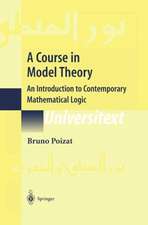An Accompaniment to Higher Mathematics: Undergraduate Texts in Mathematics
Autor George R. Exneren Limba Engleză Paperback – 5 ian 1996
Din seria Undergraduate Texts in Mathematics
- 17%
 Preț: 362.13 lei
Preț: 362.13 lei - 17%
 Preț: 365.43 lei
Preț: 365.43 lei - 20%
 Preț: 466.84 lei
Preț: 466.84 lei - 17%
 Preț: 367.24 lei
Preț: 367.24 lei -
 Preț: 351.54 lei
Preț: 351.54 lei -
 Preț: 395.09 lei
Preț: 395.09 lei - 8%
 Preț: 384.89 lei
Preț: 384.89 lei -
 Preț: 306.96 lei
Preț: 306.96 lei -
 Preț: 380.27 lei
Preț: 380.27 lei -
 Preț: 400.43 lei
Preț: 400.43 lei -
 Preț: 358.11 lei
Preț: 358.11 lei -
 Preț: 372.27 lei
Preț: 372.27 lei -
 Preț: 400.43 lei
Preț: 400.43 lei -
 Preț: 364.41 lei
Preț: 364.41 lei - 17%
 Preț: 368.61 lei
Preț: 368.61 lei -
 Preț: 433.85 lei
Preț: 433.85 lei -
 Preț: 304.91 lei
Preț: 304.91 lei -
 Preț: 290.80 lei
Preț: 290.80 lei - 13%
 Preț: 389.61 lei
Preț: 389.61 lei - 17%
 Preț: 395.93 lei
Preț: 395.93 lei -
 Preț: 407.96 lei
Preț: 407.96 lei -
 Preț: 449.62 lei
Preț: 449.62 lei -
 Preț: 415.95 lei
Preț: 415.95 lei -
 Preț: 280.65 lei
Preț: 280.65 lei -
 Preț: 370.78 lei
Preț: 370.78 lei -
 Preț: 407.63 lei
Preț: 407.63 lei -
 Preț: 339.37 lei
Preț: 339.37 lei -
 Preț: 402.35 lei
Preț: 402.35 lei - 17%
 Preț: 373.60 lei
Preț: 373.60 lei -
 Preț: 398.78 lei
Preț: 398.78 lei -
 Preț: 440.01 lei
Preț: 440.01 lei -
 Preț: 424.14 lei
Preț: 424.14 lei - 17%
 Preț: 366.38 lei
Preț: 366.38 lei -
 Preț: 367.41 lei
Preț: 367.41 lei -
 Preț: 257.71 lei
Preț: 257.71 lei - 17%
 Preț: 362.67 lei
Preț: 362.67 lei - 15%
 Preț: 417.75 lei
Preț: 417.75 lei - 17%
 Preț: 366.40 lei
Preț: 366.40 lei - 19%
 Preț: 400.52 lei
Preț: 400.52 lei -
 Preț: 298.01 lei
Preț: 298.01 lei -
 Preț: 329.95 lei
Preț: 329.95 lei - 19%
 Preț: 492.83 lei
Preț: 492.83 lei -
 Preț: 396.24 lei
Preț: 396.24 lei -
 Preț: 390.08 lei
Preț: 390.08 lei
Preț: 418.11 lei
Nou
Puncte Express: 627
Preț estimativ în valută:
80.03€ • 86.96$ • 67.27£
80.03€ • 86.96$ • 67.27£
Carte tipărită la comandă
Livrare economică 21 aprilie-05 mai
Preluare comenzi: 021 569.72.76
Specificații
ISBN-13: 9780387946177
ISBN-10: 0387946179
Pagini: 200
Ilustrații: XVII, 200 p.
Dimensiuni: 155 x 235 x 15 mm
Greutate: 0.35 kg
Ediția:1996
Editura: Springer
Colecția Springer
Seria Undergraduate Texts in Mathematics
Locul publicării:New York, NY, United States
ISBN-10: 0387946179
Pagini: 200
Ilustrații: XVII, 200 p.
Dimensiuni: 155 x 235 x 15 mm
Greutate: 0.35 kg
Ediția:1996
Editura: Springer
Colecția Springer
Seria Undergraduate Texts in Mathematics
Locul publicării:New York, NY, United States
Public țintă
Lower undergraduateCuprins
1 Examples.- 1.1 Propaganda.- 1.2 Basic Examples for Definitions.- 1.3 Basic Examples for Theorems.- 1.4 Extended Examples.- 1.5 Notational Interlude.- 1.6 Examples Again: Standard Sources.- 1.7 Non-examples for Definitions.- 1.8 Non-examples for Theorems.- 1.9 Summary and More Propaganda.- 1.10 What Next?.- 2 Informal Language and Proof.- 2.1 Ordinary Language Clues.- 2.2 Real-Life Proofs vs. Rules of Thumb.- 2.3 Proof Forms for Implication.- 2.4 Two More Proof Forms.- 2.5 The Other Shoe, and Propaganda.- 3 For mal Language and Proof.- 3.1 Propaganda.- 3.2 Formal Language: Basics.- 3.3 Quantifiers.- 3.4 Finding Proofs from Structure.- 3.5 Summary, Propaganda, and What Next?.- 4 Laboratories.- 4.1 Lab I: Sets by Example.- 4.2 Lab II: Functions by Example.- 4.3 Lab III: Sets and Proof.- 4.4 Lab IV: Functions and Proof.- 4.5 Lab V: Function of Sets.- 4.6 Lab VI: Families of Sets.- A Theoretical Apologia.- B Hints.- References.
Caracteristici
Reprint of a best-selling title The text is meant to be used interactively, frequently asking the reader to pause and work on an example or a problem before continuing Designed for students preparing to engage in their first struggles to understand and write proofs and to read mathematics independently Bridges the gap between calculus and higher mathematics


















